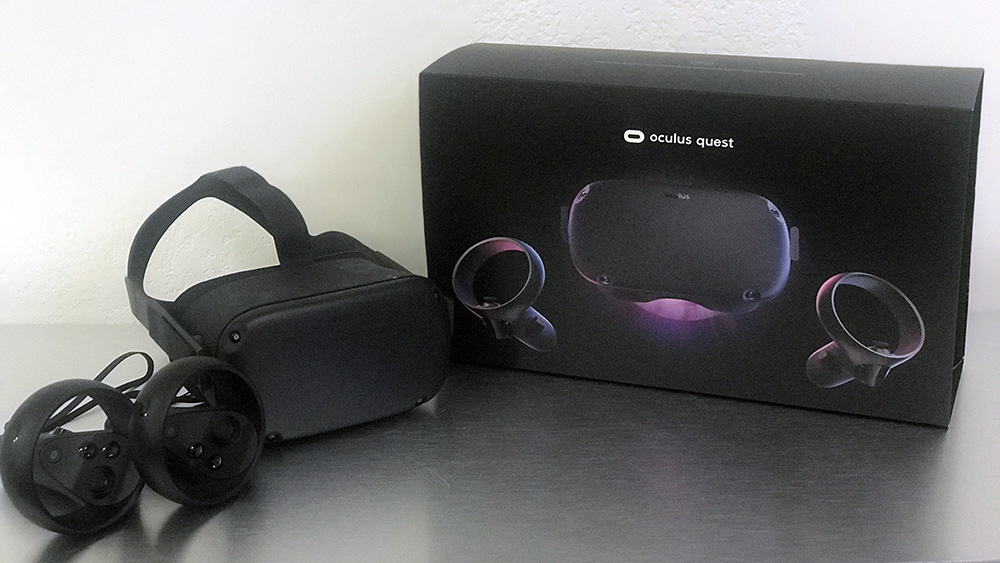
05 Jun Beat Saber on Oculus Quest
I admit – I’m pretty good at Beat Saber. It’s the perfect amount of coordination and stimulation for someone like me who thinks role-playing games are a little too immersive. I’m also a fan of EDM music so slashing cubes precisely when the beat drops raise my dopamine levels like every time I see a dog playfully pounce on a squeaky toy. Naturally, right?

I started playing Beat Saber when it was first released for the HTV Vive Pro tethered to a powerful PC with outside-in positional tracking. I never missed a “beat”, at the fault of the Vive anyways, and being tethered didn’t interrupt gameplay at all since I’m mostly facing one direction. I do hit myself in the headset occasionally but that’s the price I’m willing to pay for higher scores. (The more animated you are with your slashes, the higher your score is for each slash.) The headphones allow sounds and music to fully immerse you; the Vive’s head straps allow for a very comfortable, tight fit that rarely budged or slid. I could play for 2+ hours straight before I quit because of the sweat dripping into my eyes. However, I don’t get to play Beat Saber on Vive as much as I want because of its lack of portability and often cumbersome set-up that involves extension cords, tripods, and that darn graphics card sensor.
Then came the Oculus Quest. I was excited about this device, and still am for its potential for mass adoption of VR for gaming, and more importantly, beyond.
The biggest pros of the Quest are:
- The absence of a running PC allowing users to put on the headset, grab the controllers and instantly enter VR. It’s an easier and seamless commitment than waiting for anything to boot up, reading through notifications to update firmware, and syncing the headset, controllers, and lighthouses to each other by waving them in the air.
- No wires to run. The controllers get juice from AA batteries and a charging cord is included for the headset. While it is something to be mindful of, battery consumption is easily trackable on the menu screen. To conserve battery, the headset goes to sleep when you take it off and instantly powers up when you put it on.
- With a download of the Oculus App to Android and iOS devices and a physical update of a Chromecast to Version 3 for TV casting, users no longer have to play in isolation, pointing at nothing with blank stares from your friends as you “Oooh” and “Ahhh”. Now, the first-person view is broadcasted for everyone to follow along.
- The inside-out positional tracking ability of the Quest is a game-changer for VR devices. Without a PC and wires, all the computing happens within the headset itself. This means users have the same ability to walk-around and pick-up-things as the Vive. True VR. The Quest uses cameras as a passthrough so you can view the physical environment around you, which reminds me of a black-and-white perspective a dog might see. Now, there’s no need to take off the headset to walk to your kitchen for a refreshing glass of lemonade before continuing another sweat session in Beat Saber.
Setting up your VR play space is as simple as pointing the controller at the floor to digitally draw around obstacles in your physical space through the passthrough camera. Complete the circle and your boundary walls are created to prevent movement and collisions outside it, which only appear in VR when you get too close. If you happen to leave the play space, to your kitchen for that lemonade, for instance, the passthrough camera automatically flips on to help you navigate.
While playing my favorite VR game on the Quest, it’s hard not to notice its faults as well. Knowing all the guts are in the headset, it weighs down heavier over the front of my face, causing me to keep it lifted with my cheeks if I get too wild in my saber swings. Straining my face doesn’t allow gameplay to last as long either. The head strap slips up if my hair isn’t in a ponytail, which contributes to the face strain. The controllers’ battery covers can partially slide open in my palm on occasion. However, the speakers are great. I don’t mind that they are open so I can hear the outside world among a group of friends or coworkers.
I’m most excited about a bigger adoption of VR from the masses with a device that’s advanced enough, accessible, and simple to use as the Oculus Quest. The available games and experiences are already popular and loved by many, outside of role-playing games like Robo Recall and rhythm games like Beat Saber. However, VR still needs developers to create more games and experiences to keep audiences engaged for a long time. That’s why I love what we do at Futurus! The Oculus Quest may have finally delivered an excellent piece of VR hardware that may meet the picky needs of the masses.




